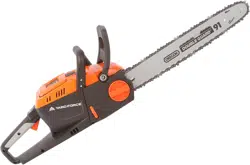Loading ...
Loading ...
Loading ...

28 29
OPERATION
Indicator panel
The indicator panel will be light ON while you squeeze the trigger switch.
Status meaning as shown in Fig. P
RH light –shows chainsaw working status –green light
.
LH light – shows chain brake status.
Proper Grip On Handles
- Wear non-slip gloves for maximum grip and protection.
- With the saw on a rm, at surface, hold the saw rmly with both hands.
- Always grasp the front handle with the left hand and the rear handle with the right.
- The ngers should encircle the handle, with the thumb wrapped under the front handle.
WARNING:
Never use a left-handed (cross-handed) grip, or any stance which would place
your body or arm across the chain line.
Proper Cutting Stance
- Both feet should be on solid ground, with weight evenly spread between them.
- The left arm should be straight, with the elbow locked. This helps to withstand the forces
generated by kickback.
- Your body should always be to the left of the chain line.
Instructions concerning the proper techniques for basic felling,
limbing, and cross-cutting
WARNING:
Always be sure of your footing and hold the chain saw rmly with both hands
while the motor is running.
WARNING:
When the saw chain is stopped due to pinching during cutting, release the trigger
switch; remove the saw chain and guide bar from the wood, then restart the chain saw.
WARNING:
Do not pull the saw chain with hand when it is bound by the sawdust. Serious
injury could result if the chain saw starts accidentally. Press the saw chain against the wood,
move the chain saw back and forth to discharge the debris. Always remove the battery pack
before cleaning. Wear heavy protective gloves when handling the saw chain.
WARNING:
Never start the chain saw when it is in contact with the wood. Always allow the
chain saw reach full speed before applying the saw to the wood.
Felling a tree
- When bucking and felling operations are being performed by two or more persons at
the same time, the felling operation should be separated from the bucking operation by a
distance of at least twice the height of the tree being felled. Trees should not be felled in a
manner that would endanger any person, strike any utility line or cause any property damage.
If the tree does make contact with any utility line, the utility company should be notied
immediately.
- The chain saw operator should stand on the uphill side of the terrain, as the tree is likely to
roll or slide downhill after it is felled.
- An escape path should be planned and cleared as necessary before cuts are started. The
escape path should extend back and diagonally to the rear of the expected line of fall.
- Before felling is started, consider the natural lean of the tree, the location of larger branches
OPERATION
and the wind direction to judge which way the tree will fall.
- Remove dirt, stones, loose bark, nails, staples and wire from the tree.
Notching undercut
Make the notch 1/3 the diameter of the tree, perpendicular to the direction of falls as Fig. 1
shown. Make the lower horizontal notching cut rst. This will help to avoid pinching either the
saw chain or the guide bar when the second notch is being made.
Felling back cut
- Make the felling back cut at least 50 mm higher than the horizontal notching cut as Fig. O
shown. Keep the felling back cut parallel to the horizontal notching cut. Make the felling back
cut so enough wood is left to act as a hinge. The hinge wood keeps the tree from twisting
and falling in the wrong direction. Do not cut through the hinge.
- As the felling gets close to the hinge, the tree should begin to fall. If there is any chance that
the tree may not fall in desired direction or it may rock back and bind the saw chain, stop
cutting before the felling back cut is complete and use wedges of wood, plastic or aluminium
to open the cut and drop the tree along the desired line of fall.
- When the tree begins to fall remove the chain saw from the cut, stop the motor, put the
chain saw down, then use the retreat path planned. Be alert for overhead limbs falling and
watch your footing.
Limbing a tree
Limbing is removing the branches from a fallen tree. When limbing leave larger lower
branches to support the log off the ground. Remove the small limbs in one cut as Fig. 2
shown. Branches under tension should be cut from the bottom up to avoid binding the chain
saw.
Bucking a log
-
Bucking is cutting a log into lengths. It is important to make sure your footing is rm and
your weight is evenly distributed on both feet. When possible, the log should be raised and
supported by the use of limbs, logs or chocks. Follow the simple directions for easy cutting.
- When the log is supported along its entire length as Fig. 3 shown, it is cut from the top
(overbuck).
50 mm
50 mm
Fig. 1
Fig. 2
Abb. 3
Loading ...
Loading ...
Loading ...
